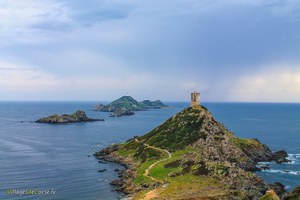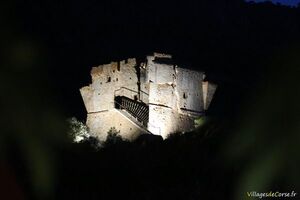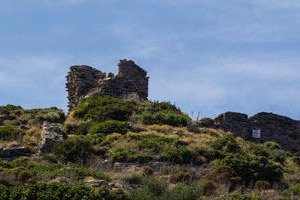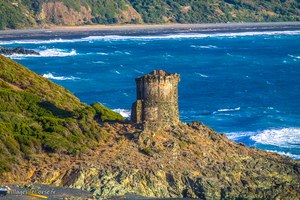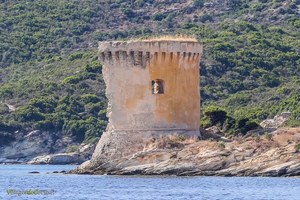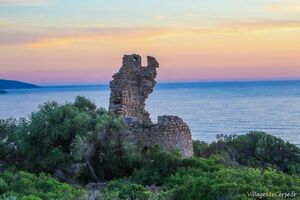The Genoese Towers in Corsica
Preventing Barbarian Incursions
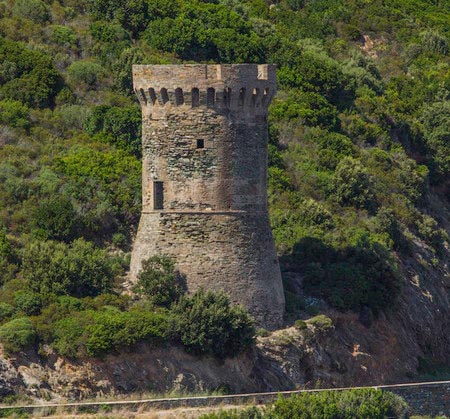
The Genoese towers were constructed along the island's coastline as fortifications designed to raise the alarm upon sighting Barbary ships offshore. These invasions, which surged particularly from the 15th century onwards after the fall of Constantinople to the Ottoman Empire, marked the beginning of raids on Mediterranean coasts, spreading death and desolation and enslaving populations.
The majority of the Corsican coastal towers were built under the impetus of the Republic of Genoa between the late 13th century and the declaration of independence in 1735, hence their generalized designation as Genoese towers.
Following these attacks and the rising insular anxiety, the Republic of Genoa decided to construct several dozen fortified towers.
Watchtowers
These structures were more about prevention than protection. Despite the machicolations and the possible presence of cannons, the towers resembled fortified dwellings on a promontory overlooking the sea, where a garrison of 2 to 6 men "i torregiani", relatively lightly armed, took turns as sentinels 24/7, their eyes fixed on the sea, dreading the appearance of pirate ships.
Alarm Signal
The alarm was immediately raised from the terrace via visual or audible signals (fires, smoke, bells) to another point further inland at the sight of enemy ships. This alert system allowed villagers to gain time, seek refuge, and be better prepared against barbarian incursions. Some towers occasionally witnessed combat between the torregiani and invaders.
Customs Posts
The towers also served a completely different role, as they functioned as customs posts for commercial exchanges.
How Many Genoese Towers Are There in Corsica?
Most of the fortified towers were built during the Genoese occupation, while some, like the Paoline Tower of Nonza, were constructed under different command. The number of fortified towers still present on the island is 83 (47 in Haute-Corse and 36 in Corse-du-Sud), with a higher concentration in Cap Corse. Nearly 8 out of 10 towers have remained in good condition, while others have been partially or completely destroyed over time, like the Padulella Tower (in San Nicolao) built in the mid-16th century, of which no trace remains. In the 18th century, at the height of enemy incursions, the island counted nearly 120 towers, with a quarter of them located in Cap Corse alone.
Characteristics of a Genoese Tower
Remarkable for their position and structure, some of which are classified as historical monuments, among the most famous are the Parata Tower in Ajaccio on the Sanguinaires Islands.
Strategically positioned, each tower has its own history. The stone used for these buildings varies according to the local geology. Thus, in Cap Corse, one finds towers made of schist stone, whereas in the south, the towers are mainly made of granite stone.
The Genoese Towers of Cap Corse
Cap Corse has the highest concentration of Genoese towers on the island, with 29 in total, 18 on the east coast and 11 on the west coast. It must be said that the people of Cap Corse paid a heavy tribute during the raids carried out by the Turks, who massacred, plundered, and enslaved the local populations.
The region, naturally open to Europe, was a land of viticulture, cereal farming, and commerce, which transitioned from prosperity to poverty after repeated assaults. In 1530, the Bishop of Nebbiu, Monsignor Agostino Giustiniani, reported a loss of 80 ships over the past six years, famine, and a generalized impoverishment of the Cap Corse population. Governor Pietro Giovanni Salvago also wrote about the cost to the villagers, who subsequently had to buy back the freedom of their family members, enslaved by the Ottoman troops. (1)
(1) Les Tours du littoral de la Corse, Sentinelles de la mer, XVI - XVIIIe siècle - Page 29 - Ouvrage d'Antoine-Marie Graziani aux éditions Alain Piazzola
